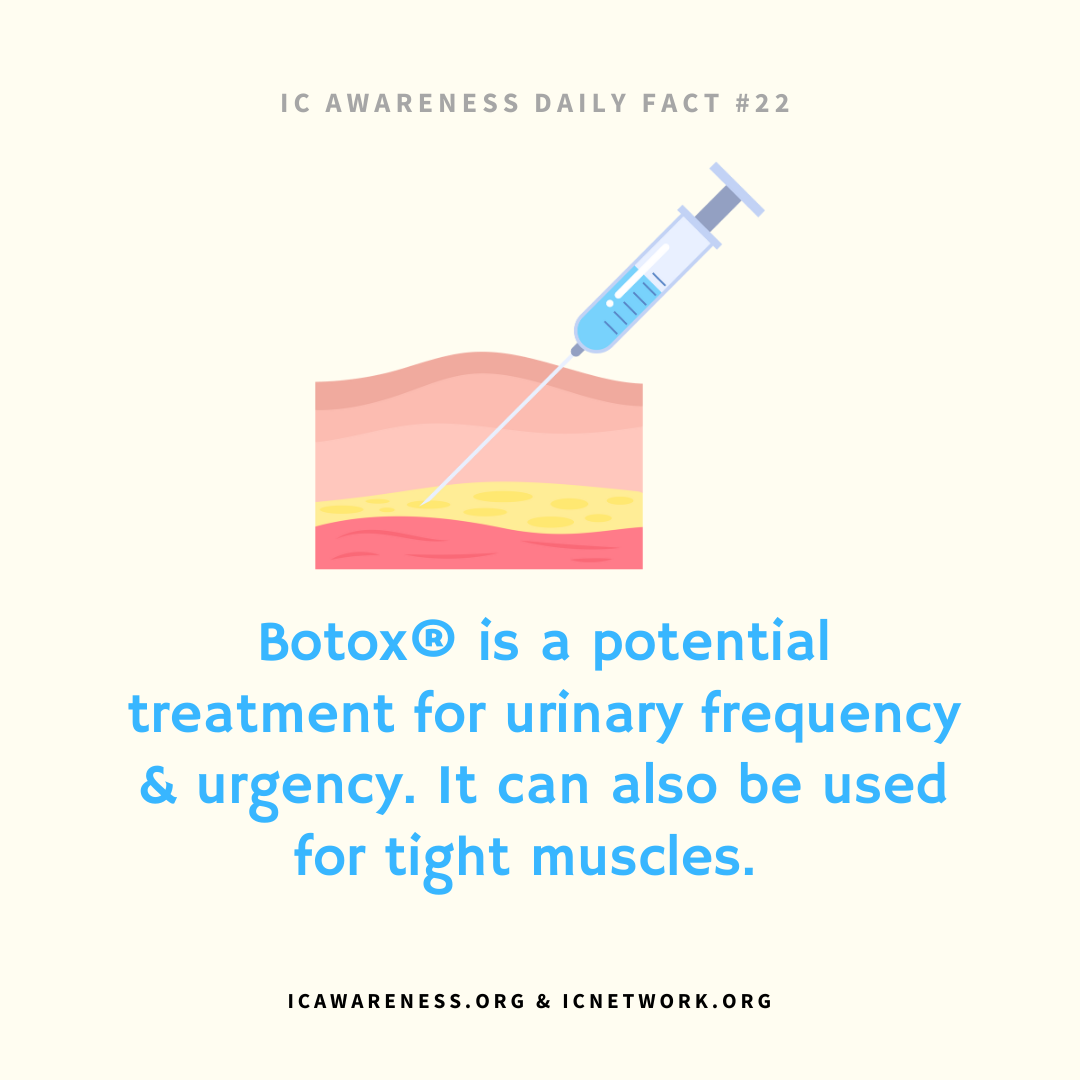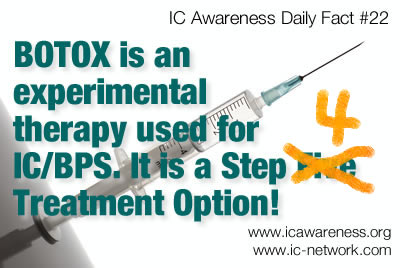
Botox is used for several bladder conditions
Botulinum toxin is neurotoxin produced by the bacterium Clostridium Botulinum. When found in contaminated meat, it can cause botulism, a potentially deadly disease in humans and animals. In 1928, researchers also discovered that it can block nerve transmissions. In the 1980′s, it was first used to treat some eye problems, including strabismus (crossed eyes) and uncontrollable blinking (belpharospasm). It has since been used to treat spasm of the lower esophageal sphincter, frown lines, TMJ, migraines, dystonia and patients with upper motor neuron syndrome, such as cerebral palsy. When injected into a tight muscle, botox can relax the contraction thus allowing for better movement and so forth.
Botox and the Bladder
In the bladder and/or pelvis, Botox has been studied with tight pelvic floor muscles (vaginismus), incontinence and IC/BPS. In the bladder, it is injected into the bladder wall in multiple sites during a hydrodistention procedure. Research studies have shown modest success. One study reported efficacy of 69% (1). Two studies reported high initial efficacy rates of 74% and 86% at three months.(2)(3) Another showed that frequency improved significantly at 3.5 months.(4) Effectiveness diminished over time, however, and at one year symptoms were indistinguishable from baseline values.(5) One study reported a low efficacy rate at 3 months with only 20% of patients exhibiting improvement.(6)
Risks & Potential Adverse Events of Botox Therapy
BOTOX can cause urinary retention, especially when used at the higher dosage of 200 units. The AUA suggests using the lower dosage of 100 units to reduce this risk. They also state that it should not be pursued by patients who cannot self catheterize and is contraindicated for patients with impaired bladder emptying. Botox has also been linked to far more serious side effects, including fatalities.
Patient Tip: If you are considering the use of Botox, please carefully review the AUA Treatment Guidelines first and make sure that you have tried other, less invasive and risky therapies, first.
References
- Smith JL: Case of the month. Interstitial cystitis. JAAPA 2004; 17: 48.
- Liu HT and Kuo HC: Intravesical botulinum toxin A injections plus hydrodistension can reduce nerve growth factor production and control bladder pain in interstitial cystitis. Urology 2007; 70: 463.
- Giannantoni A, Costantini E, Di Stasi SM et al: Botulinum A toxin intravesical injections in the treatment of painful bladder syndrome: a pilot study. Eur Urol 2006; 49: 704.
- Ramsay AK, Small DR and Conn IG: Intravesical botulinum toxin type A in chronic interstitial cystitis: results of a pilot study. Surgeon 2007; 5: 331.
- Giannantoni A, Porena M, Costantini E et al: Botulinum A toxin intravesical injection in patients with painful bladder syndrome: 1-year followup. J Urol 2008; 179: 1031.
- Kuo HC: Preliminary results of suburothelial injection of botulinum a toxin in the treatment of chronic interstitial cystitis. Urol Int 2005; 75: 170.
- FDA Notifies Public of Adverse Reactions Linked to Botox Use. Fda.gov. Retrieved on 2012-05-06.
TikTok Video
@icnetworkjill IC Awareness Dsily Fact 22 – Botox is a potential treatment option! #ic #pelvicpain #icawarenessmonth ♬ original sound – IC Network

